|
Last modified on August 21, 2010
For a list of rule-outs for infectious disease in rodents, click
here.
Hamsters
Gerbils
Cotton rats
White-footed mice (Peromyscus) (warning,
might be Muridae)
Voles (Microtus)
Taxonomy
Genetics/Nomenclature Anatomy Physiology Uses
in Research
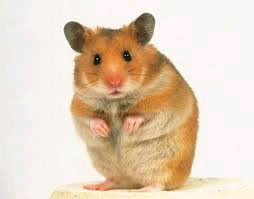 Hamsters belong to the order
Rodentia, family Cricetidae{3989}.
This family is characterized by thick bodies, short tails, cheek pouches,
incisors that grow continuously and molars that do not. They are nocturnal.{3566} There is debate over whether
hamsters belong in the family Muridae with mice or the family Cricetidae.
Arguments against inclusion in the Muridae include the fact that the tail is
different (no scales, no bristles, no length), molar cusp differences (hamsters
have two parallel rows of cusps, mice have three rows in transverse ridges). The
ACLAM text places hamsters in a subfamily of the family Cricetidae called
Cricetinae. There are 7 genera: Cricetus, Cricetulus, Mesocricetus,
Phodopus, Tscherskia, Mystomys and Calomyscus. The
genus Mesocricetus was finally established in 1940; they differ from Cricetus
by having shorter tails, smaller size, and more mammary glands. Hamster karyotyping
has been extensive.{3995} Hamsters belong to the order
Rodentia, family Cricetidae{3989}.
This family is characterized by thick bodies, short tails, cheek pouches,
incisors that grow continuously and molars that do not. They are nocturnal.{3566} There is debate over whether
hamsters belong in the family Muridae with mice or the family Cricetidae.
Arguments against inclusion in the Muridae include the fact that the tail is
different (no scales, no bristles, no length), molar cusp differences (hamsters
have two parallel rows of cusps, mice have three rows in transverse ridges). The
ACLAM text places hamsters in a subfamily of the family Cricetidae called
Cricetinae. There are 7 genera: Cricetus, Cricetulus, Mesocricetus,
Phodopus, Tscherskia, Mystomys and Calomyscus. The
genus Mesocricetus was finally established in 1940; they differ from Cricetus
by having shorter tails, smaller size, and more mammary glands. Hamster karyotyping
has been extensive.{3995}
The Syrian or Golden hamster is Mesocricetus auratus,
weighing 110-140 gm, 2N=44. Most of the following information relates to
Syrian hamsters, as the others are very rarely used in research.
Turkish hamster = Mesocricetus brandti, look like
Syrians but hard to breed, used in hibernation and comparative studies with
Syrians{3988}.
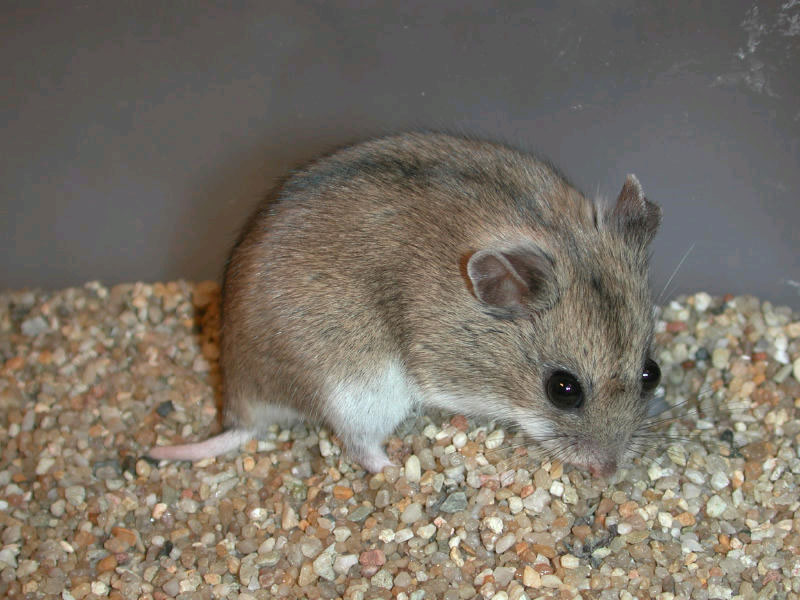 Chinese hamster = Cricet(ul)us griseus or C. barabensis{3995}: gray-black, 30-35 gm, very
aggressive and solitary; low diploid number, 2N=22; naturally occurring
diabetes mellitus{3988}. CHO cells are the "E. coli of the mammalian world" because of their use to produce therapeutic recombinant proteins. Chinese hamster = Cricet(ul)us griseus or C. barabensis{3995}: gray-black, 30-35 gm, very
aggressive and solitary; low diploid number, 2N=22; naturally occurring
diabetes mellitus{3988}. CHO cells are the "E. coli of the mammalian world" because of their use to produce therapeutic recombinant proteins.
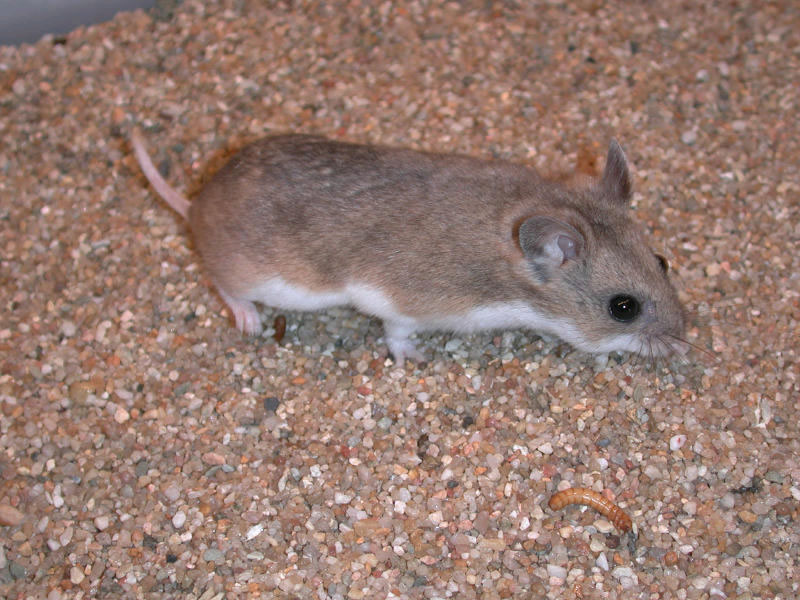
Armenian or gray hamster = Cricetulus migratorius, 2n=22,
cytogenetics and oncology. {3988}
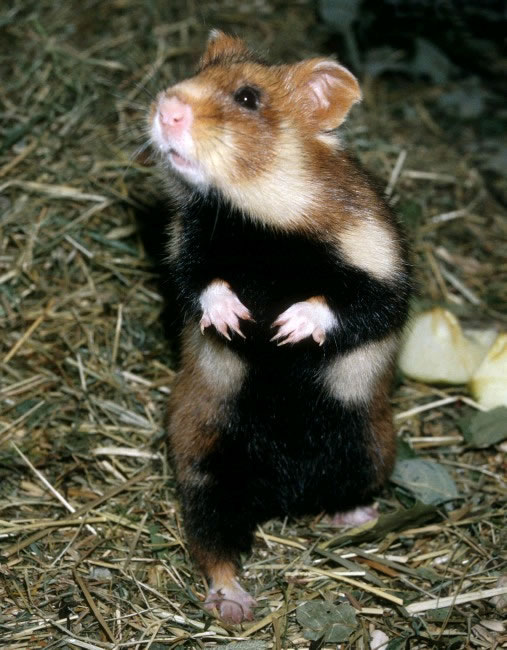 European or black-bellied hamster = Cricetus cricetus, very large,
almost the size of a guinea pig {3988}. Adults weigh 300-400 grams. Used for smoke-inhalation studies, but there are no breeding colonies available in the US. Most studies involve hibernation, as they are "true hibernators". Despite their cuteness, they are very aggressive, especially the females. {4758}According to Wikipedia, these "common hamsters" were a real farm pest since they eat so much. They are found from Belgium and Alsace eastward to Russia and south to Romania. However, the war on hamsters was so successful that they are now on the International Union for the Conservation of Nature and Natural Resources (IUCN) Red List of Threatened Species, and are designated as Critically Endangered, meaning that their numbers will decrease by 80% within three generations. The last remaining colony in Alsace was suffering because farmers were growing maize instead of cabbage, and when the hamsters emerge from hibernation in March there is nothing for them to eat. European or black-bellied hamster = Cricetus cricetus, very large,
almost the size of a guinea pig {3988}. Adults weigh 300-400 grams. Used for smoke-inhalation studies, but there are no breeding colonies available in the US. Most studies involve hibernation, as they are "true hibernators". Despite their cuteness, they are very aggressive, especially the females. {4758}According to Wikipedia, these "common hamsters" were a real farm pest since they eat so much. They are found from Belgium and Alsace eastward to Russia and south to Romania. However, the war on hamsters was so successful that they are now on the International Union for the Conservation of Nature and Natural Resources (IUCN) Red List of Threatened Species, and are designated as Critically Endangered, meaning that their numbers will decrease by 80% within three generations. The last remaining colony in Alsace was suffering because farmers were growing maize instead of cabbage, and when the hamsters emerge from hibernation in March there is nothing for them to eat.
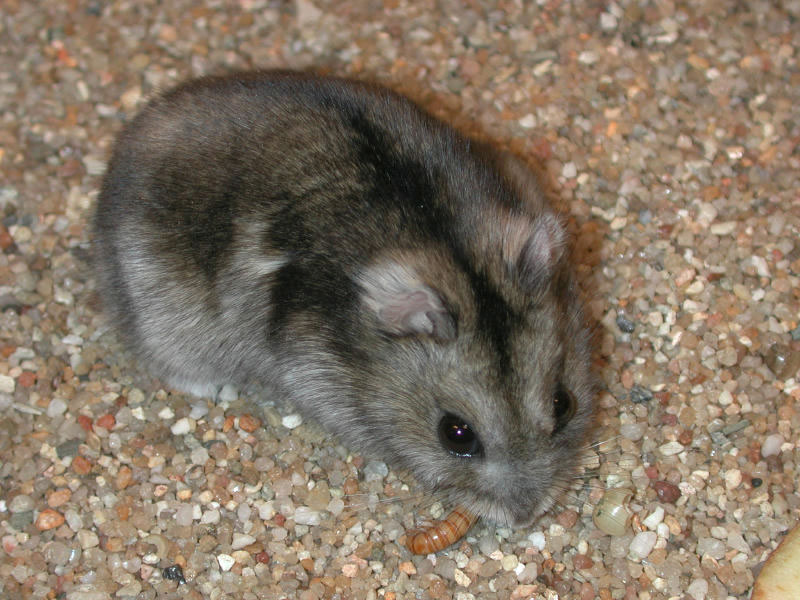 Dzungarian (Siberian) hamster = Phodopus
sungorus, gray with a midline black stripe on the back, relatively tame.{3988} Another reference {4091} calls these "dwarf hamsters" of
two different species. P. sungorus is the Siberian hamster, and P.
campbelli is the Djungarian hamster. They are small, <40gm, native to
the steppes of Siberia, have thick fur, short limbs, and a short tail. They
differ in the importance of the male parent for survival and growth because
of "physiologic constraints on female reproduction." Dwarf hamsters
have also been studied for the endocrinology of the photoperiod, puberty,
maternal endocrinology, and separation stress. According to LAM2 this species has "the most compressed reproductive cycle of any eutherian mammal" (aka good test question). Females have a fertile post-partum estrus, unlike most hamsters, and the gestation period is 18 days. They can therefore have a second litter while weaning the first, in 36 days. Females are quite non-aggressive and mating pairs can remain together for life. The critical photoperiod is 13 hours (12.5 hr for Syrians and 15.5 for Europeans). They do NOT hibernate, even if exposed to temperatures of -40C.{4758} Dzungarian (Siberian) hamster = Phodopus
sungorus, gray with a midline black stripe on the back, relatively tame.{3988} Another reference {4091} calls these "dwarf hamsters" of
two different species. P. sungorus is the Siberian hamster, and P.
campbelli is the Djungarian hamster. They are small, <40gm, native to
the steppes of Siberia, have thick fur, short limbs, and a short tail. They
differ in the importance of the male parent for survival and growth because
of "physiologic constraints on female reproduction." Dwarf hamsters
have also been studied for the endocrinology of the photoperiod, puberty,
maternal endocrinology, and separation stress. According to LAM2 this species has "the most compressed reproductive cycle of any eutherian mammal" (aka good test question). Females have a fertile post-partum estrus, unlike most hamsters, and the gestation period is 18 days. They can therefore have a second litter while weaning the first, in 36 days. Females are quite non-aggressive and mating pairs can remain together for life. The critical photoperiod is 13 hours (12.5 hr for Syrians and 15.5 for Europeans). They do NOT hibernate, even if exposed to temperatures of -40C.{4758}
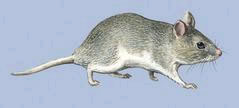 South African hamster = Mystromys albicaudatus, estivates, nocturnal, gray on the back with whitish belly, long tails, no
cheek pouches and no gall bladder; used in diabetes and leishmaniasis
research{3988}. South African hamster = Mystromys albicaudatus, estivates, nocturnal, gray on the back with whitish belly, long tails, no
cheek pouches and no gall bladder; used in diabetes and leishmaniasis
research{3988}.
Hamster
Top of page
Several genetic variants are available
for study.
- The BIO (R) 14.6 strain suffers from a form of muscular dystrophy
similar to the mdx mouse. The dystrophic hamster is a model of limb-girdle
muscular dystrophy with sarcoglycan deficiency in which one of the
dystrophin-associated glycoproteins, delta-sarcoglycan, is defective{3993}. Muscle lesions develop first in
the heart causing a fatal cardiomyopathy.
- BIO (R) 4.24 females are obese. They also have a high
incidence of benign adrenal adenoma.
- BIO (R) 12.14 is a sex-linked mutation with
progressive hindlimb paralysis by 10 months of age.{3566}
- BIO 15.16 is used in smoke inhalation studies.{4758}
- One strain, the LHC/LAK is
susceptible to scrapie and
transmissible mink encephalopathy.
Creutzfeldt-Jacob disease can also be transmitted to hamsters, making them a
valuable model for these slow virus diseases all in a single host.
- There is a nude hamster with a
recessive mutation that arose spontaneously in 1982. They have a rudimentary
thymus and are hairless. Unlike their rat and mouse counterparts, their NK cell
activity is normal, rather than increased. They should be housed in SPF
conditions and mated by heterozygous female x homozygous male.{4162}
Hamster
Top of page
 | Dental formula: I1/1 C0/0 PM0/0 M3/3=16; open-rooted
incisors. The molars are "cuspidate" and do not grow continuously{3566}. Hamsters develop dental caries depending on the form and
quantity of carbohydrate in their diet. |
 | Body weight 110-140gm, females larger |
 | Males can be distinguished from females by (1) prominent flank
glands and (2) large testicles that make the posterior pointed rather than
rounded when viewed dorsally. |
 | Flank glands are sebaceous with pigment cells and terminal
hairs. The hair over the glands is coarse, and the skin darkly pigmented.
Glands are located in the costovertebral area. The male secretes in response
to androgens. When excited, the glands become wet. The hamster may use them
to mark its territory. The female has smaller glands; she secretes in
association with the estrous cycle.{3566} |
 | Cheek pouches are used to collect food during foraging.
Hamster cheek pouches are an immunologically privileged site due to the lack
of lymphatic drainage and glandular tissues. |
 | Gall bladder present |
 |
Two parts of stomach: forestomach or cardiac, and glandular or pyloric stomach. The nonglandular stomach is similar to the ruminant; it contains fermentative microorganisms and has a high pH. {4758}
. |
 | Fat pads in lower abdomen next to testes; males have
seminal vesicles, coagulating glands, prostate, ampulla and bulbourethral
glands |
 |
Kidneys are unipapillate and renal
pelvis allows high concentration of urine; urine is milky white due to calcium
carbonate, pH 8{3989}. The hamster kidney is highly responsive to estrogens; males treated wtih estrogen get renal tumors.{4758}
. |
 | Lungs: single left lobe, 4 right lobes. There are few glands in the upper respiratory tract, and
hamsters develop lesions of centrilobular emphysema like those of man. |
 | Brown fat in interscapular area |
When performing studies with infectious organisms it is
important to know how intraperitoneally-administered particulates are
distributed. This has been studied in mice, rats, rabbits, cats, dogs, sheep,
cattle, swine, monkeys, and recently hamsters. The lymphatics of the peritoneal
side of the diaphragm have stomata that overlie lacunae which can accommodate
particles at least up to 22 microns in size. Trans-diaphragmatic transport of
solutions is considered the main route of fluid drainage from the peritoneal
cavity. The absorbed material arrives by lymphatic transport in the cranial and
caudal mediastinal lymph nodes within a few minutes. Much of it is taken up by
macrophages there, leading to a "clogging up" and perhaps slowing
further transport. Some marker leaks past the RE cells and gets into the blood,
ending up in the spleen and liver. Interestingly, it also goes to the bone
marrow. Another route of passage is in the vaginal tunic to the testis. This may
explain the occurrence of Strauss phenomenon (described in 1907), fulminant
orchitis in hamsters and guinea pigs after ip bacterial inoculation with Burkholderia
mallei, the causative agent of glanders.{4133}
Hamster
Top of page
 | Lifespan 2-3 years{3989} |
 | Body temp 36.2° C – 37.5° C{3989}. For a table of thermoneutral
zones, click
here. |
 | HR 280-412{3989} |
 | RR 33-125{3989} |
 | Food consumption 10-15 gm /day{3989} |
 | Water consumption half that of rats:
5ml/100gm/day{3989} |
 | They are extremely resistant to
radiation. |
 | Penicillin may cause fatal enterocolitis in guinea pigs and hamsters, possibly related to Clostridium difficile{4177} |
Blood volume of a male dwarf hamster (Phodopus)=3.0-3.5ml.
One to 1.2ml can be removed from the retro-orbital sinus in a single sample,
and the hematocrit will return to normal immediately, suggesting splenic
replenishment. With repeated sampling, a 5-day rest period may be needed if
hematocrit declines to 70% of original values.{4091}
They hibernate if the temperature reaches 5°C, although since they do not store large
amounts of energy they must wake up periodically to eat.{4758}
Although hamsters are not plagued with many infectious
diseases, they do develop a number of spontaneous and viral-induced tumors and
display chemical carcinogenic sensitivities that are useful in research. For
example, renal carcinoma, urinary bladder tumors, estrogen-linked pituitary
adenomas, pancreatic tumors, bile duct carcinomas, papillomas and
adenocarcinomas in the forestomach and intestines, and adenomatous polyps in
the colon have all been described.{3566}
Renal cell carcinoma is rare in Siberian hamsters (Phodopus sungorus);
rather, more common neoplasms include tumors of the mammary gland, skin, lungs,
and thyroid gland{3789}.
Hamsters can harbor viruses from other species (a sarcoma
became a carrier of LCMV which
infected other hamsters and humans). Adenoviruses from many species
(man, NHP, bovine, chicken) cause tumors (sarcomas at site of injection) in
newborn hamsters. This has been exploited for oncology research. In particular,
these studies have led to the discovery of early genes, produced within hours
of infection. The gene products (of genes E1A and E1B) are seen as intranuclear flecks
in T cells, but are not involved in T-cell-mediated immunity. The proteins bind
to and inactivate tumor suppressor genes p53 and Rb, thereby causing malignant
transformation{3777}. This can be
useful as a screening tool in humans, to see if the tumors are of viral
etiology. However, the system gets very complicated when examining whether
adenovirus-transformed cells grow in an older hamster, or in an immunodeficient
mouse or rat.{3771}
The immune system of the hamster is very interesting because
it is less susceptible to alloantigens; also hamsters have no IgD and are
deficient in the sixth component of complement.
Reproduction
 |
Short estrus (4 days), short gestation (16
days), and large litters make them useful for teratology |
 |
Unique post-ovulatory
discharge which is viscous and cream-colored and has a peculiar odor (a common
CL Davis slide) |
 |
Breed at 8-10 weeks{3989}, breeding life 1 year{3566} |
 |
Very photoperiod sensitive
via melatonin secretion from pineal gland |
 |
Mating systems:{3990} |
1.
Trial period: house individually until single male housed with
single female, checking for lordosis. Introduce male to female 3 days after
appearance of post-ovulatory discharge, 1 hour before start of dark cycle{3989}
2.
Harem: House 1 male with 1-2 females for 7-14 days, and remove
females before parturition
 | Gestation 15-18 days{3989} |
 | Females produce litters of 4-12 pups approximately 6 times
per year{3566} |
 | Leave mom and pups alone 7-10 days{3989} to prevent cannibalism; only
fresh water is needed. |
 | Wean between 21-28 days, after which the mother comes back
into estrus |
Hamster
Top of page
 |
Hamster oocytes can be penetrated by human sperm. They are still used to aid in assessing human male fertility using the zona-free hamster oocyte assay.{4758}
|  |
microvascular studies of cheek pouches: inflammation, tumor growth, vascular smooth muscle function
|  | relatively low incidence of natural tumors, but highly susceptible to viral oncogenesis from foreign viruses (i.e. human adenoviruses{3771}), estrogens,
but not radiation; pancreatic tumors are similar to those of man |
 | immunobiology: neonate is immunologically more mature than other rodents;
lack suppressor T cells and CTLs are atypical; MHC is very similar so they
can accept skin grafts from each other |
 | genetic model for atrial thrombosis (left atrium first), epilepsy
(BIO86.93sz/Bio), muscular dystrophy (BIO14.6cm/Bio and BIO53.58cm/Bio) |
 | teratology |
 | neuroscience and behavior |
 | caries and periodontal disease: Streptococcus mutans and S.
salivarius;
model was used to demonstrate fluoride’s effect |
 | Helicobacter aurati-associated gastritis associated with
Alcian-blue-positive goblet cells is a pre-malignant finding. Syrian
hamsters may be an interesting model of human Helicobacter
gastritis.{4045}{4053} |
 | Hamsters fed a fat-rich diet develop hyperlipidemia and diabetes can be
induced with streptozotocin. Advantages include (1) hamsters also use LDL as
the main cholesterol carrier, (2) hamster LDL receptor gene has been
characterized, (3) they develop atherosclerotic plaques in similar places,
(4) vascular events are similar, (5) animals become hyperglycemic rapidly
after streptozotocin.{3971} |
Hamster
Top of page
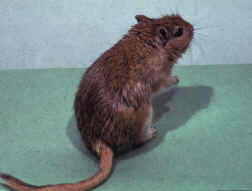 Gerbils are any member of the subfamily
Gerbillinae, containing at least 10 genera and 100 species. They belong to the
family Cricetidae of the suborder Myomorpha. The Mongolian gerbil, Meriones
unguiculatus, is the species most often used in research in the US and
Japan. The first 20 pairs were trapped in eastern Mongolia in 1935 and taken to Japan. Eleven pairs were imported to the US in 1954. Common names for M. unguiculatus include jird, sand rat, desert
rat, and antelope rat. Most are brownish or gray with pale bellies, but black
and albino mutants occur. Most gerbils are outbred; however there is one inbred
strain, MON/Tum.{3560, 4635}
For a list of infectious diseases in gerbils, click here. Gerbils are any member of the subfamily
Gerbillinae, containing at least 10 genera and 100 species. They belong to the
family Cricetidae of the suborder Myomorpha. The Mongolian gerbil, Meriones
unguiculatus, is the species most often used in research in the US and
Japan. The first 20 pairs were trapped in eastern Mongolia in 1935 and taken to Japan. Eleven pairs were imported to the US in 1954. Common names for M. unguiculatus include jird, sand rat, desert
rat, and antelope rat. Most are brownish or gray with pale bellies, but black
and albino mutants occur. Most gerbils are outbred; however there is one inbred
strain, MON/Tum.{3560, 4635}
For a list of infectious diseases in gerbils, click here.
 |
Adult body weight ranges 70-150gm; females average either 50-55 or 70-80gm, males either 60 or 80-90gm depending on which reference you read {4635}
|
 | Tail is fully haired |
 | Rear legs much longer than the forelegs |
 |
Sebaceous gland located on the ventrum (larger in males) which secretes a
musky material under the influence of sex hormones.{3560, 4635}
|
 |
Very large adrenal glands, approximately 3-4 times the
weight of rat adrenals on a relative weight basis.{3560, 4635} |
 | Sometimes develop over-secretion of the Harderian glands,
leading to facial dermatitis which starts at the nose and can spread to the
face and front feet. Housing on sand can help prevent this condition, and
antibiotic treatment has also been tried. Nasal dermatitis often develops at relative humidites >50%, so low humidity is advisable; the Euroguide recommends 45+/- 10% humidity for gerbils instead of 55+/- 10% as for other rodents.{4635, 4770}
|
 | They have a very wide temperature tolerance, with high
tolerance to heat.{3560} |
 | Their RBCs have a life span of
only 10 days or so, with a high percentage of circulating reticulocytes.{3560} |
 |
Gerbils lack a posterior communicating artery between the carotid and vertebro-basilar arteries in the midbrain. Unilateral occlusion of the common carotid artery provides a model of stroke.{4767, 4635}
|
 |
Gerbils may have spontaneous seizures when stimulated, an
inherited problem. Seizures begin as early as 2 months of age. They are reflexive to sensory stimulation and are clonic-tonic. Incidence in a
colony may be as high as either 20-40% (LAM2) or 40-80%. These are similar to those of human idiopathic epilepsy.{3560, 4635}
|
 | They also develop high serum and liver cholesterol without
atherosclerosis, even on low (4%) fat diets.{3560} |
 | Adult gerbils drink only about 5ml water per day{3560} |
 |
Gerbils have been used to study filariasis, and have been
experimentally infected with Brugia
pahangi, B. malayi, Litomosoides carinii, and Dipetalonema viteae. They appear to be wonderful for maintaining and studying various parasites in the lab: Giardia, Babesia, Strongyloides, Ostertagia, Haemonchus; filarial worms like Wuchereria, Brugia, and Onchocerca; hydatids like Echinococcus granulosus and E. multilocularis, Taenia polyacantha and T. crassiceps; flukes such as Schistosoma and Paragonimus. However, they don't really have that many parasites naturally.{4635}
|
 | Gerbils are extremely sensitive to dihydrostreptomycin, with
a single dose of 50mg causing death within 1-7 minutes. Note that this is an
extremely high dose of the antibiotic.{3560}{4177} |
 | Gerbils apparently are either deficient in complement, or it is of low
activity{3535} |
Reproduction
 | Gerbils are diurnal;
they have periods of intense activity
alternating with sleep.{3560} |
 | They are docile when housed alone or in pairs; but do not
mix groups of adults, as the fighting may result in severe injury and death{3560} |
 | A gerbil should be picked up at the base of the tail, and
then supported with the other hand. They don't like being placed on their
backs. If they are excited they will jump and dart around.{3560} |
Iatrogenic, neoplastic and age-related problems {4635}
Dihydrostreptomycin (in a penicillin/dihydrostreptomycin/procaine combo) caused death in 80-100% of gerbils in a 1980 report.
Gerbils are prone to epileptiform seizures from a young age, seen more commonly in some lines than others. About 20-40% can show seizures, which are induced by noise or stress. They are usually fairly short and have no lasting effects.
Age-related problems have been reported as neoplasia and chronic interstitial nephritis. Gerbils also have a high incidence of aural cholesteatoma.
Gerbils
Top of page
Taxonomy
Genetics/Nomenclature Physiology Behavior
Uses in Research
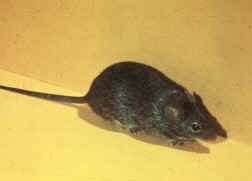 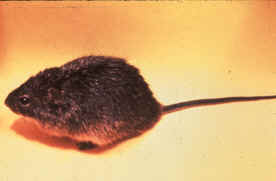 There are seven species of cotton rats, but
the most common laboratory species are either Sigmodon hispidus (at
left) or Sigmodon fulviventer (at right). The name Sigmodon
refers to S-shaped enamel loops on the grinding surfaces of the cheek teeth.
These animals are widely distributed in the wild from the southern US, north to Virginia, west to California, and
south to Mexico, Central America, and northern south America. Cotton rats are
members of the family Cricetidae, and are nest building rodents living in
burrows or dense clumps of vegetation.{3841} There are seven species of cotton rats, but
the most common laboratory species are either Sigmodon hispidus (at
left) or Sigmodon fulviventer (at right). The name Sigmodon
refers to S-shaped enamel loops on the grinding surfaces of the cheek teeth.
These animals are widely distributed in the wild from the southern US, north to Virginia, west to California, and
south to Mexico, Central America, and northern south America. Cotton rats are
members of the family Cricetidae, and are nest building rodents living in
burrows or dense clumps of vegetation.{3841}
Cotton rat
Top of page
The number of chromosomes varies
among species from 22 to 52. Anatomy is similar to other rodents.
Cotton rat
Top of page
These animals may be nocturnal,
diurnal, or crepuscular in activity. Social groups consist of males dominating
females and adults dominating the young. Generally they live as solitary
animals, forming groups for reproduction. Young can survive in the wild by 5
days of age.{3841}
There are four life stages:
juvenile (1-75 days); young adults (76-200 days); adults (201-300 days); and
old adults (>300 days). Captive-bred animals have an average lifespan of 2-3
years.
Breeding is seasonal in the wild,
but not in the lab. They may be harem bred, or placed in monogamous pairs.
Pairs should be established when the female has reached puberty. Earlier
pairing seems to delay puberty. The estrous cycle averages 9 days, there is a
postpartum estrus, gestation is about 27 days, young are born haired and eat
solid food by one week of age. Normally they are weaned at 3-5 weeks of age,
but they can be weaned as young as 5-10 days.{3841}
House the males separately to avoid fighting. Ideal temperature range is
60-80; below that they hunch up and above it they pant. Moving them to a clean
cage can be done by tipping them towards the clean cage while covering the rest
of the opening with the other hand; they can be picked up by scruffing or
whole-body holds.{4174}
Test sentinels for bacteria, viruses (PVM,
Reo3, MEV, Sendai,
LCMV,
SDAV, KRV,
hantavirus), protozoa (Spironucleus, Giardia, Entamoeba, trichomonads, Eimeria),
ectoparasites (Myobia, Myocoptes, Radfordia, Polyplax, Psorergates,
Notoedres, Demodex, Liponyssus) and helminths (Syphacia, Aspiculuris,
Hymenolepis, Trichosomoides).{4174}
Blood can be collected from the retro-orbital sinus, or with terminal cardiac
puncture. Use isoflurane or ketamine (25mg/kg)/xylazine (7.5mg/kg)/acepromazine
(2.5mg/kg).{4174}
For a comparative table of
reproductive values in several non-traditional rodents, click here.
Cotton rat
Top of page
Cotton rats can be housed in large
polycarbonate rat cages. They should have locking lids, and bedding for
nesting. Nutritional requirements are similar to those for rats. A high-fat chow
(i.e. Teklad 7004) can be used for nursing mothers. They are also
best handled like rats; some people prefer to wear leather gloves. Avoid
picking them up by the tail as the tail skin easily degloves.{3841,
4174}
Cotton rat
Top of page
The cotton rat is susceptible to
many human pathogens, thus making it a valuable model in biomedical research.
They were originally used to model human polio since it is the only small
animal permissive for it. Now they are used for respiratory syncytial virus,
human parainfluenza virus 3, human adenoviruses, and pineal gland
studies.{4174} They
have been used as a recipient of adenovirus vectored human genes for cystic
fibrosis and a 1-antitrypsin in the lung.{3929} Female
cotton rats also develop gastric adenocarcinomas, which have been compared with
human enterochromaffin-like cell (ECL) carcinomas.{4203}
Anesthesia, blood sampling, and
light cycles can be the same as for other rodents such as rats.{3841}
The orbital plexus can be used for survival procedures, and cardiac puncture for
terminal bleeding. IV injections can be given directly IC since there are no
readily accessible peripheral veins.{4174}
There are at least 40-50 different species
in this genus, many of which are commonly called white-footed mice because the
abdominal fur is white, and the dorsal fur ranges from gray to brown. Their
natural range encompasses all of North America and extends south as far as
Colombia. Within this range, individual species generally inhabit a limited
portion, with the exception of the deer mouse (P. maniculatus) which
inhabits most of the total range. Some species that have been maintained in the
laboratory include P. leucopus, P. maniculatus, P. floridanus, P. bairdi, and
P. polionotus.{3560}
A recent article in Comparative
Medicine places deer mice in the family Muridae, subfamily Sigmodontineae.
Deer mice (Peromyscus) are "the most widely distributed indigenous
small mammal on the continent." They are claimed to be very easy to maintain
in captivity, and are furthermore the natural reservoir of several human
pathogens: Lyme disease,
granulocytic ehrlichiosis,
babesiosis, bartonellosis, and hantavirus.
They are the predominant carrier of the Sin Nombre strain of hantavirus, which
is highly pathogenic. This led to a CDC recommendation for new, safer handling
of the mice. Wild-caught mice should be quarantined and tested for SN after 5
weeks. Breeding pairs are best left alone; use highly-absorbent bedding and
change it only about every 2-3 weeks.{4579}
Peromyscus
leucopus
(right)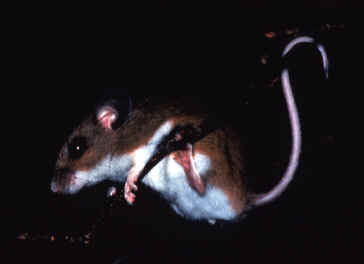
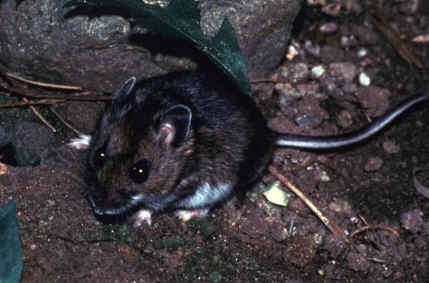 Peromyscus maniculatus (left), which is used in
studies of Hanta virus. Peromyscus maniculatus (left), which is used in
studies of Hanta virus.
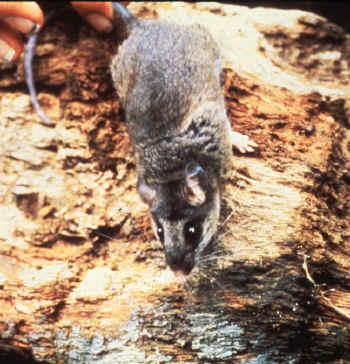 Peromyscus
mexicanus nudipes
(right), the naked-footed deer mouse. Peromyscus
mexicanus nudipes
(right), the naked-footed deer mouse.
Peromyscus behavior that has been studied includes
food hoarding, maternal care, feeding patterns and light preference. Several
species exhibit idiopathic epileptic seizures, and the clonic and tonic phases,
recovery and post-seizure behavior are reported to be almost identical to those
in man.{3560}
The mice can be housed in similar
style as Mus, but care must be taken during cage transfers as they may
jump. Animal transfer is best managed in a box with sides at least 30cm high.{3560}
When used in studies of hanta virus infection, they must be housed using ABSL4
procedures.{3950}
Like most New World rodents, the
demarcation between the cardiac and pyloric portions of the stomach is not as
distinct as it is in Old World rodents (such as Mesocricetus and
Mystromys). Stratified squamous epithelium in the cardiac portion is
thought to protect the stomach from abrasion caused by rough feed.{3560}
Reproduction
White-footed mice have been
successfully bred in captivity. They can be caged in groups. In their natural
habitat their reproductive peak is during long days (spring, summer and early fall),
so in the lab a light: dark ratio of 15-16: 8-9 works best. After about three
litters, reproductive performance declines.{3560}
|
|
P. leucopus
|
P. maniculatus
|
|
Adult weight, gm
|
22
|
19-21
|
|
Life span
|
2-3
yr (max. 38 mon.)
|
|
|
Chromosome #
|
|
48
|
|
Puberty
|
42-48
days
|
35-37
days
|
|
Estrous cycle length
|
4-5
days
|
4-5
days
|
|
Gestation
|
22-24
days
|
23
days
|
|
Litter size
|
2-7
|
1-11
|
|
Birth weight, gm
|
1.5-2.4
|
1.3-2.2
|
|
Eyes open
|
12-15
days
|
12-16
days
|
|
Weaning
|
21-28
days
|
21-28
days
|
Top of page
Voles (Microtus)
There are around 50 species of
voles, and they are found throughout the world. Microtus pennsylvanicus,
the Eastern meadow vole or field mouse, has been raised in the laboratory. Its
natural habitat is the eastern US, Canada, and Alaska. The common vole (M.
arvalis) is a very common European mammal. Like some other wild rodents,
they tend to be escape artists, very excitable, and rarely become tame. More
secure caging and more care during cage changes is necessary. Dim red light may
help with handling nocturnal animals, which have a high percentage of rods in
their retinas that are not sensitive to red light.{3560}
Some voles are exceedingly
prolific. M. arvalis females mature as early as 14 days of age, have 4-7
young per litter and have a new litter every 3 weeks.{3560}
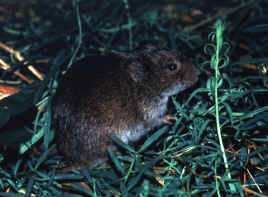 This is Microtus
pennsylvanicus, the Eastern meadow vole, at right. This is Microtus
pennsylvanicus, the Eastern meadow vole, at right.
Meadow voles are reported to be
good bioassay animals for digestibility of forages and for protein content of
feeds. Females are induced ovulators, with ovulation occurring 12-18 hours
after mating.{3560}
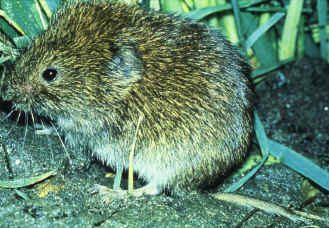 This is Microtus
agrestis, the field vole, at left. This is Microtus
agrestis, the field vole, at left.
This is Microtus
chrotorrhinus, the rock vole or yellow-nosed vole, at right.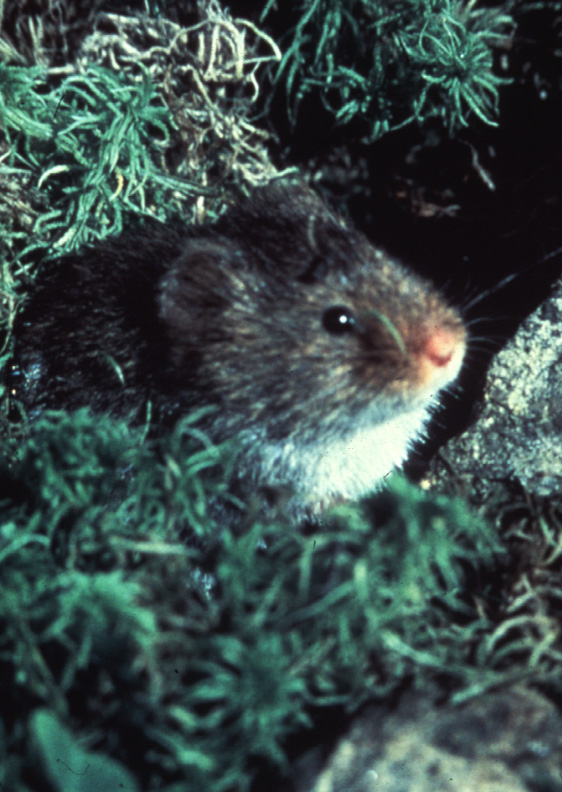
 |
Adult weight: 40-60 gm |
 | Life span: 33 weeks, 124 weeks maximum |
 | Food consumption: 7-10 gm/day |
 | Chromosome number: 46 |
 | Puberty: 42 days in males, 25 days in females |
 | Estrous cycle length: 5 days |
 | Gestation: 21 days (19-22) |
 | Litter size: 4 (1-11) |
 | Birth weight: 2 gm |
 | Eyes open: 8 days |
 | Weaning: 14 days{3560} |
Top of page
|
